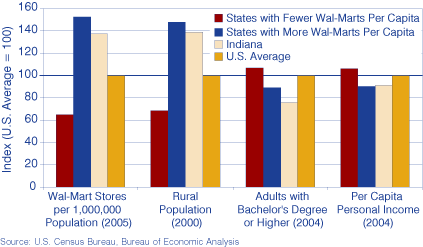The Wal-Mart Phenomenon—A Demographic Comparison of Wal-Mart Have and Have Nots
The February 25, 2006, issue of The Economist ran a brief story called “The Behemoth from Bentonville,” in which the author discussed Wal-Mart's growth and power. The article states that “Wal-Mart panders to no one but its customers, mostly small-town Americans enticed by its promise to provide everyday low prices, always.”
A recent review of Dun & Bradstreet's Million Dollar Database shows 3,814 Wal-Mart Stores in the United States, an average of 13 stores for every million people (see Table 1). With 424 stores, Texas leads the nation, Indiana has 107 stores and the District of Columbia has none. Per capita, however, Arkansas ranks highest with 41 stores per million people, while Indiana ranks 16th with 17 per million people. There are 29 states, including Indiana, with a higher than average number of stores per million people; collectively, these states have an average of 20 stores per million. Twenty-one states have a lower than average number, a mean of around 8 stores per million people.
Table 1: Wal-Mart Stores by Geography
Comparing those states with a higher than average number of Wal-Mart stores per person to those states with a lower than average number, one finds some striking differences (see Figure 1).
Figure 1: Wal-Mart Index Based on U.S. Average

Whereas 21 percent of the nation's population is rural according to the 2000 Census, the population of the states with more Wal-Mart stores is 31 percent rural; the population of the other states is only 14.4 percent rural.
According to the Bureau of Economic Analysis, the U.S. per capita personal income in 2004 was $33,040. For states with more Wal-Mart stores, that number drops to $29,766 while the figure climbs to $35,207 for states with fewer stores.
With respect to educational attainment, the Census Bureau's Current Population Survey shows that in 2004, 28 percent of Americans 25 years and older had at least a bachelor's degree. Fewer adults (25 percent) have a bachelor's degree or higher in the states with more Wal-Mart stores per capita, while 30 percent of adults in the states with relatively few stores have at least a bachelor's degree.
Frank Wilmot, State Data Coordinator
Indiana State Library

